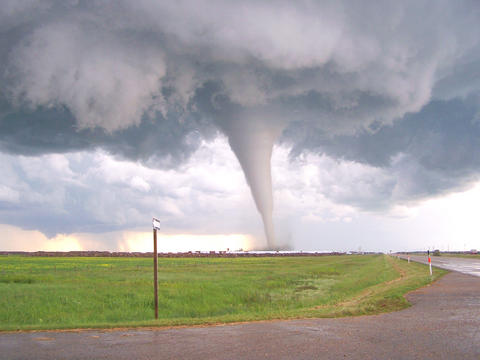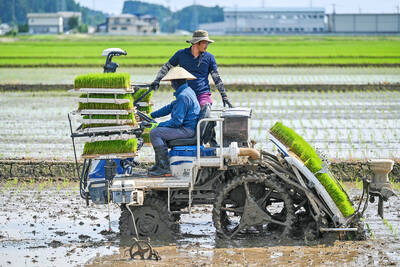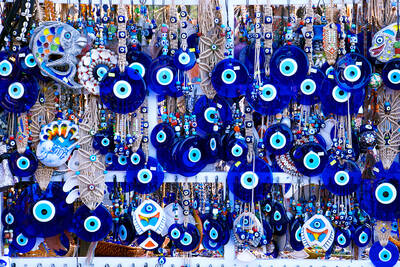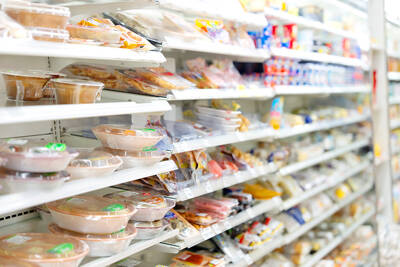This is a photo of a tornado that hit a small town in Canada on June 22. It was one of three reported in Canada that day. Four homes were destroyed by the tornado, but luckily no one was injured.
Tornadoes can happen anywhere in the world, but the most tornadoes are seen in a place called Tornado Alley in the Mid-west of the US.
Scientists don't fully understand tornadoes, but one theory is that they form when a warm wind meets a cold wind.

PHOTO: AP
A thunderstorm high up in the atmosphere makes the layers of air move. The warm humid air from near the ground gets pushed up into the cold dry air above it. If the wind changes speed and direction, then a tornado might form.
As the two winds spiral round they form a vortex. The wind can reach up to 480km an hour! That's very strong. Tornadoes can pick up objects, animals, and even people sometimes.
If you ever see a tornado you should make sure that you get into shelter as fast as possible.
這是六月二十二日侵襲加拿大某個小鎮的龍捲風照片,據說是當天在加拿大發生的三場龍捲風之一。這場龍捲風摧毀了四間民舍,所幸無人受傷。
世界各地都有龍捲風發生,但全球龍捲風最多的地方是美國中西部的「龍捲風小徑」。
科學家並未完全了解龍捲風,但有一種理論說,當溫暖的空氣遇上冷空氣時,龍捲風就可能成型。
大氣層高空降下大雷雨時,層層的空氣就會流動。靠近地面濕暖的風,就會向上流到乾冷風中。假如風改變了速度與方向,龍捲風就可能成形。
這兩種風旋轉時,會形成渦流。風速可達每小時四百八十公里,相當強勁!龍捲風會捲走物品、動物,甚至於人類。
假如你看到了龍捲風,務必儘快躲進避難所。

Rice is essential to Japanese culture, tradition and politics. People take pride in the oval-shaped sticky Japonica grain, which is still a staple even though total consumption has fallen over the decades. But since last summer, prices have soared as supplies have fallen short of demand. The government has long paid farmers to cut back on rice acreage, and change to other crops to keep rice prices relatively high. To cope with shortfalls this year, the government has released rice reserves. But the grain has been slow to reach supermarket shelves. Anger over that was part of the reason the Agriculture Minister

In Taiwan, 7-Eleven convenience stores can be found on almost every street corner. With over 84,600 stores across 20 countries, 7-Eleven has more locations than any other retail business on Earth. For millions of people, the chain is an important part of daily life, providing coffee, quick meals, and essential items for those __1__. The history of 7-Eleven began nearly 100 years ago in Dallas, Texas. In 1927, the Southland Ice Company began selling blocks of ice that were used to keep fridges cool. Shortly after opening, the company __2__ its offerings to include groceries like milk, eggs, and

Step into any corner of Turkiye, and you’ll likely encounter the iconic “Evil Eye,” known as “nazar boncu?u” in Turkish. This striking blue glass ornament is shaped like an eye with concentric circles of dark blue, white, and light blue. While its name in English suggests something threatening, it’s actually a charm designed to ward off misfortune. The origins of the nazar boncu?u can be traced back to ancient Mediterranean and Middle Eastern traditions. The word nazar comes from Arabic, meaning “gaze,” while boncu?u translates to “bead” in Turkish. Central to the nazar boncu?u’s mythology is the idea that

Continued from yesterday(延續自昨日) https://www.taipeitimes.com/News/lang In 1946, the company adopted the name 7-Eleven to reflect its newly extended __3__, from 7am to 11pm, a novel concept at the time. As a rapidly growing company, it began offering franchise opportunities in the 1960s. In 1974, the first 7-Eleven in Japan was opened by the supermarket company Ito-Yokado. The Japanese franchises were __4__ successful that by 1991, Ito-Yokado was able to acquire a 70 percent stake in Southland Corporation. Its investments eventually resulted in full ownership of 7-Eleven, which paved the way for the Japanese company to enter the international market. Since then, 7-Eleven